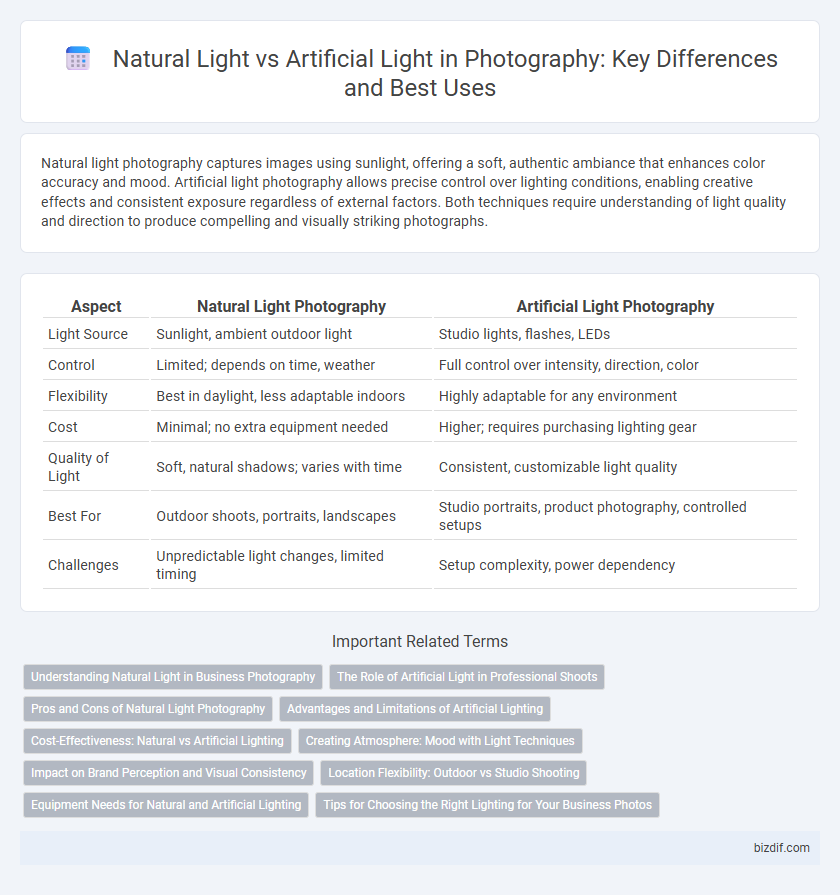Natural light photography captures images using sunlight, offering a soft, authentic ambiance that enhances color accuracy and mood. Artificial light photography allows precise control over lighting conditions, enabling creative effects and consistent exposure regardless of external factors. Both techniques require understanding of light quality and direction to produce compelling and visually striking photographs.
Table of Comparison
| Aspect | Natural Light Photography | Artificial Light Photography |
|---|---|---|
| Light Source | Sunlight, ambient outdoor light | Studio lights, flashes, LEDs |
| Control | Limited; depends on time, weather | Full control over intensity, direction, color |
| Flexibility | Best in daylight, less adaptable indoors | Highly adaptable for any environment |
| Cost | Minimal; no extra equipment needed | Higher; requires purchasing lighting gear |
| Quality of Light | Soft, natural shadows; varies with time | Consistent, customizable light quality |
| Best For | Outdoor shoots, portraits, landscapes | Studio portraits, product photography, controlled setups |
| Challenges | Unpredictable light changes, limited timing | Setup complexity, power dependency |
Understanding Natural Light in Business Photography
Natural light photography in business settings leverages ambient sunlight to create authentic, vibrant images that enhance brand storytelling and convey trustworthiness. Mastery of natural light involves understanding its intensity, direction, and color temperature throughout different times of the day to optimize subject appearance and mood. Utilizing natural light can reduce production costs and streamline workflows while delivering compelling visual content that resonates with customers.
The Role of Artificial Light in Professional Shoots
Artificial light plays a crucial role in professional photography by providing consistent, controllable illumination that enhances the subject's features and mood regardless of natural lighting conditions. Studio strobes, LED panels, and softboxes allow photographers to shape light intensity, direction, and color temperature precisely, creating dramatic effects or soft, even lighting as needed. Mastery of artificial light techniques ensures high-quality, repeatable results in portraits, product photography, and commercial shoots, overcoming limitations posed by natural light.
Pros and Cons of Natural Light Photography
Natural light photography offers the advantage of soft, diffused illumination that enhances natural skin tones and reduces harsh shadows, making it ideal for portraiture and outdoor shoots. However, its dependence on weather conditions and time of day limits shooting flexibility and consistency, posing challenges for controlled environments. Photographers must adapt to fluctuating light intensity and color temperature, which can affect exposure and require quick adjustments in camera settings.
Advantages and Limitations of Artificial Lighting
Artificial light photography provides consistent and controllable lighting conditions, allowing photographers to shoot in any environment regardless of time or weather, which is crucial for studio portraits and product photography. However, artificial lighting setups can be expensive and require technical knowledge to manipulate effectively, potentially limiting spontaneity and increasing setup time. Despite these constraints, artificial light offers unparalleled flexibility in shaping mood, direction, and intensity, making it essential for creative and commercial photography.
Cost-Effectiveness: Natural vs Artificial Lighting
Natural light photography offers significant cost-effectiveness by eliminating the need for expensive lighting equipment, reducing setup time and electricity expenses. Artificial light photography, while initially costly due to purchasing and maintaining lights, provides precise control over lighting conditions and consistent results regardless of time or weather. Balancing cost with creative control depends on the photographer's project needs and budget constraints.
Creating Atmosphere: Mood with Light Techniques
Natural light photography leverages the sun's dynamic qualities to create authentic moods, often producing warm, soft glows during golden hours and dramatic shadows at sunrise or sunset. Artificial light photography offers precise control over intensity, color temperature, and direction, enabling photographers to craft consistent atmospheres such as high-key brilliance or moody, low-key dramatics. Mastering light modifiers like diffusers, reflectors, and gels is essential for shaping ambiance and enhancing emotional impact in both natural and artificial lighting setups.
Impact on Brand Perception and Visual Consistency
Natural light photography enhances brand perception by delivering authentic, warm visuals that resonate with audiences seeking realism and natural beauty, strengthening emotional connections. Artificial light photography offers precise control over shadows, colors, and highlights, ensuring consistent branding across diverse campaigns and environments. Balancing these lighting techniques aids in maintaining visual consistency while reinforcing desired brand identity through tailored imagery.
Location Flexibility: Outdoor vs Studio Shooting
Natural light photography offers unmatched location flexibility, allowing photographers to capture images in diverse outdoor environments such as parks, beaches, and urban settings without the need for equipment setup. Artificial light photography, typically conducted in studio settings, provides controlled lighting conditions but restricts the shooting location to indoor spaces equipped with lights, modifiers, and backdrops. The choice between natural and artificial light impacts creative possibilities, with natural light enabling spontaneous shoots in varied locations and artificial light ensuring consistency and precision in studio environments.
Equipment Needs for Natural and Artificial Lighting
Natural light photography relies primarily on available sunlight, requiring minimal equipment such as reflectors or diffusers to manipulate light, making it a cost-effective option. Artificial light photography demands specialized gear like studio strobes, continuous lights, softboxes, and light meters to control illumination precisely and achieve desired effects. Proper understanding of each setup's equipment needs enhances image quality and creative control in both natural and artificial lighting environments.
Tips for Choosing the Right Lighting for Your Business Photos
Natural light photography enhances portraits and product shots with soft, flattering tones and natural shadows, making it ideal for businesses seeking authenticity and warmth. Artificial light photography offers precise control over lighting conditions, enabling consistent results in any environment, which is crucial for brand consistency in online stores or corporate headshots. Assess your business's visual identity, shooting location, and desired mood to select lighting that aligns with your brand's message and appeals to your target audience effectively.
Natural Light Photography vs Artificial Light Photography Infographic

 bizdif.com
bizdif.com